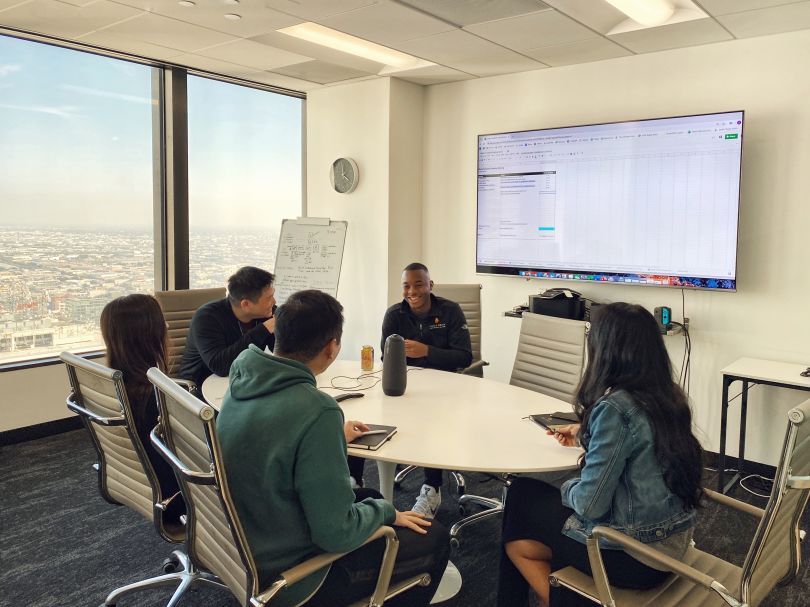For many new startups, it’s hard to explain their technology on a billboard. A fresh audience might be confused to read how Airbnb operates from the highway, for example.
When Airbnb’s engineering team developed a feature that let the company host listings on Craigslist, however, they were able to target a wide audience looking for short-term rentals. Advertising strategies integrated with engineering? That’s part of growth marketing.
And thanks to growth marketing, outdated marketing strategies like ‘spray and pray’ are getting an upgrade. According to Product Marketing Manager Nikhil Naidu at Yotpo, it’s now a brand’s job to create different messages that fit under the same campaign that can speak to the consumer at different points in the buyer’s journey.
“Growth marketing will solidify itself as the catchall term for highly measurable marketing activities,” said Director of Growth Marketing at DigitalOcean David Dorman.
With better market research, AI-driven chatbots and small-budget testing on social media platforms, marketing managers have more tools than ever to reach their target audience and tell the story of their brand. We asked 15 marketing managers about what growth marketing trends they are watching and what marketing professionals can do to start leveraging those trends, today.
Growth Marketing Trends To Watch
- Machine learning
- Data privacy
- SMS marketing
- Omnichannel marketing
- Product-led growth
- Internal market research
- Lifecycle marketing

FabFitFun
FabFitFun’s Vanessa Landivar is very aware of the small window all brands have to make an impression. The senior manager of acquisition marketing recommends taking a full-funnel approach to any media-buying strategy.
What growth marketing trends are you watching in the year ahead and why do you think these trends will be important?
There is no one-size-fits-all recipe for success. The landscape is constantly shifting and requires us to consistently put innovation ahead of reactivity. From the emergence of niche social platforms like Reddit, Quora and TikTok to streaming wars among the entertainment studios and increased demand for CTV or OTT players like Roku, Hulu and beyond, the bid for a user’s attention transcends any vanity cost per mille. Once we win the impression, we have a small but mighty window to win the conversion, so content is king.
"Make sure your media-buying strategy measures incremental lift.’’
What are some simple steps product and marketing pros can take to start leveraging these trends in their work?
Our mission is to deliver happiness and well-being to everyone, everywhere. We do that by starting with a personalized shopping experience. In an age where consumption is evolving more rapidly than ever before, employing a tailored creative strategy that leans on quenching a thirst for knowledge, discovery and entertainment is key.
Make sure your media-buying strategy measures incremental lift. By focusing on a full-funnel approach across our media mix, we are able to increase reach and conversions, ultimately leading toward brand affinity, loyalty and retention.

MeUndies
At MeUndies, the entire team takes a consumer mindset before launching creative marketing initiatives. This exercise begins with employees imagining a customer initially seeing an ad and ends as they consider them opening their shipped product. Growth Strategy Manager Meagan Yip recommends other product and marketing professionals incorporate creative thinking into the sales funnel as soon as possible.
What growth marketing trends are you watching in the year ahead?
Two trends come to mind: machine learning and incorporating creativity throughout the sales funnel. Many advertising platforms are integrating machine learning into every part of marketing. Whether machine learning is integrated for more accurate targeting, smarter bidding or better recommendation engines, technology-empowered decision-making will give brands an advantage over their competition.
Additionally, the digital and mobile revolution continues to alter consumers’ purchase journey. Brands must communicate cohesive messaging and compelling “reasons to believe” in a short period of time. A 15-second ad now needs to do the same amount of heavy lifting as a 60-second ad.
"A 15-second ad now needs to do the same amount of heavy lifting as a 60-second ad.’’
What are some simple steps product and marketing pros can take to start leveraging these trends in their work?
Collect quality data to inform decision-making. Invest in solid data infrastructure and event tracking. If your site events are not tracking or not sending proper signals for the machine learning algorithms to learn user behavior, you won’t be able to optimize your growth goals.
At MeUndies, the marketing, analytics and digital product teams work collaboratively to ensure proper set up, QA and tracking to the best of our ability. Additionally, we collaborate closely with our brand and creative teams for cohesive, full-funnel campaigns.

Fandango
Fandango CMO Lori Pantel recommends growth marketers refine the one-on-one relationship established with a consumer as part of their performance marketing approach to advertising. Prior to Fandango, Pantel spent over a decade at Mattel, where she led branding efforts and digital strategy execution across the entire portfolio.
What growth marketing trends are you watching in the year ahead?
Continuing to refine and watch all elements of performance marketing will be even more important as we continue with KPI-driven activities. It’s a challenge for many brands to measure true effectiveness past the walled gardens of platforms like Google and Facebook. More and more companies are jumping at the chance to build direct-to-consumer opportunities. Beware; this is harder than it looks. Brands must be authentic and nurture the consumer relationship.
Companies must be acutely aware of the competitive landscape. Don’t assume that someone who was once a loyal customer will always be a loyal customer. Consumers are looking for more from businesses. Switching costs are not as high as they once were. Focus not only on new consumer acquisition, but also on retention.
"Don’t assume that someone who was once a loyal customer will always be a loyal customer.’’
What are some simple steps product and marketing pros can take to start leveraging these trends in their work?
I think this is a continually evolving space and continuous learning is key. Ask questions and never be afraid to admit you don’t understand. Surround yourself with smart talent and lean on partners. Find peers from other industries and learn about what they are doing and facing.
In terms of loyalty/retention, it’s important for marketers to really understand what motivates their customer base. Ensure you are delivering on the elements that are most meaningful while balancing economics.

GreenPark Sports
John Liu, director of growth at GreenPark Sports, takes a scientific approach to marketing. Liu tries to understand his customer base as clearly as possible before making any final strategy decisions. Another differentiator that’s worked for him? Doubling down on what works best.
What growth marketing trends are you watching in the year ahead?
Ad networks continue to take control away from advertisers as more and more is driven by automated, machine learning-based systems powered by data within a single-walled garden. Combined with ever-mounting scrutiny on data privacy, growth marketing will lean more heavily on creative execution and the ability to understand and manipulate these ad network algorithms. Retention will also continue to become ever more important to growth as net new users become more difficult to acquire.
"The secret to successful marketing continues to be a scientific approach to testing and experimentation.’’
What are some simple steps product and marketing pros can take to start leveraging these trends in their work?
The secret to successful marketing continues to be a scientific approach to testing and experimentation. Make sure you have a strong theory of who your customers are, their segmented needs and how your product serves those needs. Develop marketing messages and hypotheses based on that understanding and test your hypotheses in the market. Take those learnings and double down on what’s been successful and resonant and update your hypotheses accordingly. Continually refine your understanding of your business while driving your bottom-line growth and acquisition goals, leading to ongoing growth.

Conversmart
In 2019 the average person spent just over three hours a day on their phone, according to productivity software company RescueTime. Conversmart Managing Director Arri Bagah keeps this in mind when helping clients reach potential customers. And he has a few tips for other growth marketers looking to do the same.
What growth marketing trends are you watching in the year ahead?
The resurgence of SMS marketing. For over 15 years, brands had the ability to text their customers. And most did not because they were either afraid of the regulations around SMS or of annoying their customers. Historically, brands have to be where the consumer is. If the average consumer is spending most of their time inside messaging apps, brands should reach them there. Because SMS marketing is regulated, it’s a much better experience for the end consumer. Brands now have the ability to reach their customers directly using text messaging. And many of our clients at Conversmart are generating six to seven figures in incremental revenue through SMS alone.
"Send content that is relevant and timely.’’
What are some simple steps product and marketing pros can take to start leveraging these trends in their work?
If you are collecting emails on your e-commerce site, offer your customers the ability to subscribe using a phone number as well. Make sure to check with a lawyer to ensure opt-in compliance. From there, send content that is relevant and timely. Keep it short, causal and use GIFs to keep the user’s attention and increase conversions. Lastly, if you have promotions, send them to your subscribers.

Single Grain
Single Grain CEO Eric Siu doesn’t take a one-and-done approach to marketing. He said he repurposes content depending on where he believes it will best serve users. Below, Siu shared how the digital marketing agency’s brand has specifically benefited from guest carousel posts.
What growth marketing trends are you watching in the year ahead and why do you think these trends will be important?
Take an omnichannel approach for any content you create by repurposing what you already have. Nowadays, people are on all channels and you don’t want to put all your eggs in one basket. For example, you can record a YouTube video and upload shorter snippets from that video to TikTok, or turn the audio into multiple podcast episodes.
To take it even further, extract memorable quotes and use those to create Instagram posts, which you can also post on LinkedIn and Pinterest. Not only are you saving time, you’re getting the largest possible return on the time you invested up front.
"If you don’t have a large following, you can collaborate with someone who does.’’
What are some simple steps product and marketing pros can take to start leveraging these trends in their work?
Guest carousel posts work really well on Instagram and LinkedIn because you can communicate your message succinctly. Start by repurposing any listicle blog post — say, “5 Tips for Preparing Healthy Meals in 30 Minutes Per Week,” and turn those tips into a carousel. Imagine five images that users can swipe through, with a call-to-action at the end asking them to follow you for more tips.
If you don’t have a large following, you can collaborate with someone who does. Offer to create a carousel for them to post on their page. When we tested this ourselves, we gained more than 600 Instagram followers through one guest carousel. We then repurposed this same content and posted it to our own social media channels.

Genly
Genly Co-Founder Karen Porat tracks the company’s media wins back to users’ first clicks on their digital campaigns in real time. That way, she has clear data to report their marketing methods’ success. Porat said that Genly optimizes its clients’ inbound lead generation campaigns based on the ads, forms and audiences that generate the highest demo set rates.
What growth marketing trends are you watching in the year ahead?
This year, growth companies are more focused than ever on increasing their demo set rates and are looking to AI as the tool that will help them achieve their 2020 KPIs. Demand managers are not only accountable for generating high quantities of qualified inbound leads for their sales development representatives, but are also partnering in the sales process in a more meaningful way. As a result, they will be turning to technology that will allow them to increase their demo set and win rates through intelligent attribution and optimization.
"This year, growth companies are more focused than ever on increasing their demo set rates.’’
What are some simple steps product and marketing pros can take to start leveraging these trends?
Make sure that every inbound lead can be linked to its originating campaign and creative, and that every sales interaction is documented correctly in your customer relationship management systems. Accurate data is key in order for AI to be effective, so tracking every piece of information in your funnel (click-through rates, conversion rates, time that lead was generated, etc.) will be crucial for an AI-enabled platform to integrate your data points and increase your demo sets and overall performance.
Incorporating AI into marketing technology is a big part of Genly’s vision to create a growth on-demand platform that’s designed to help managers hit their goals.

SimplePractice
Director of Growth Design Jeff Doan is focused on consumer motivation. He emphasized the importance of targeting potential customers who could benefit from an SaaS platform like SimplePractice. In order to grow awareness, Doan recommends identifying any factors in the customer journey that could cause consumer skepticism in competitor solutions.
What growth marketing trends are you watching in the year ahead?
The growth marketing trend I’m watching in 2020 involves product-led growth. It is a hot term, and for good reason. Products that customers enjoy using make the whole process easier. But what if you have a product that your customers don’t know they need?
That’s where we see growth processes moving into the marketing world. It’s a buyer’s market now. With so many SaaS products to choose from, growth teams really need to understand what motivates a customer to convert and show value as soon as possible. It sounds easy, but many marketers assume they know this information.
I’m excited about digging into internal and external factors that plant the seed of doubt in your customer base with a current solution. If you can understand these factors, you can tailor your message around how your product fixes them and clearly demonstrates the tangential benefits provided.
"Always be learning. Test the small things. Talk to your customers.’’
What are some simple steps product and marketing pros can take to start leveraging these trends?
Always be learning. Test the small things. Talk to your customers. If you’re constantly exposed to new ideas, you’ll be able to try out ideas on a more frequent basis because you never know what is going to work best. For example, a big long-term project (for me, it’s onboarding) doesn’t mean you can’t fix leaky holes in the short term. It means getting to know your data inside and out: what’s working, what’s not and trusting your gut. If you think something is confusing or could be better, it likely could. The most important and probably the simplest step is to talk to your customers. There’s no better resource than people who actually use your product. Ask yourself questions like, “Why did the most recent customer sign up?” Look for common patterns to ideate around.

Prodege
At Prodege, VP of Growth Marketing Andrew Robinson knows quite a few outreach hacks, one of which is adjusting settings on Google AdWords to make sure specific content is visible to your entire user base. Robinson currently oversees the growth marketing team for the Swagbucks and MyPoints brands at the data and insights solutions company.
What growth marketing trends are you watching in the year ahead?
I believe that privacy will continue to grow as a priority concern in consumers’ minds. More users will actively opt out of ad tracking and will appreciate privacy-oriented messaging. Large tech firms will continue to move to cater to those concerns and position themselves as market leaders in user privacy. This trend will have a growing impact on growth marketers’ ability to target audiences on social and search platforms. These platforms will likely need to reduce the visibility advertisers currently have into who is interacting with their ads in order to meet the privacy expectations of their user bases.
"Want better attribution on Apple Search Ads? Try targeting those in the 18-65 age bracket.’’
What are some simple steps product and marketing pros can take to start leveraging these trends?
Here are a few tricks of the trade: Google AdWords currently allows ad targeting by age, gender and geo. However, the age bands start at 18 to 24 years old. There are Google users under 18. Google doesn’t want to highlight targeting minors for obvious reasons, but in the process, they include all these users in the “unknown” age bucket. If you are not interested in driving AdWords clicks from teens, try suppressing “unknown” ages.
Similarly, Apple Search Ads doesn’t allow attribution on users that have “limit ad tracking” enabled. Want better attribution on Apple Search Ads? Try targeting those in the 18-65 age bracket. This will suppress ads from all “limit ad tracking” users, improving attribution rates dramatically.

Yotpo
Yotpo helps brands accelerate direct-to-consumer growth. Product Marketing Manager Nikhil Naidu said it is important to gather data on internal performance for the brands he works with in order to best tell their message. Using data analysis and company-wide interviews, Naidu and his team is able to deliver customers new insights.
What growth marketing trends are you watching in the year ahead and why do you think these trends will be important?
There are two trends I am particularly interested in following in 2020.
The first trend is combining targeting with “spray-and-pray” marketing. Since we have access to so much data on who our prospects are, marketing teams tend to craft targeted messaging by building very specific personas and developing a matrix comparing certain personas to a buyer’s journey. This can often lead to a false sense of what the “right” answer is. For a particular persona at a particular point in the buyer’s journey, there are at least five different messages that might resonate. I'm interested in following the businesses that are able to take their personas and target them with a series of different messages.
The second trend is internal market research. After talking with marketers at almost every company, data is something we all wish we had more of. Industry data and product performance data often take center stage and are really important foundations, but qualitative internal data is often overlooked and easily accessible. Internal teams have vast and up-to-date knowledge on which messages, features and assets work and which don't.
"Data is something we all wish we had more of.”
What are some simple steps product and marketing pros can take to start leveraging these trends in their work?
Starting to leverage spray-and-pray messaging can start with advanced planning and be as simple as drafting out more options that might work for each persona. When we’re thinking about a prospective customer within a specific business segment, we try to compile a list of new features, existing competitive advantages and value props to make sure that we are able to attempt as many messages as possible and not only understand which work best, but also capture more market share because we are using more diverse messaging.
Gathering data on internal performance is a combination of internal data analysis and conducting regular interviews with different teams within the organization. Internal data analysis, similar to external data, can be difficult to gather. We’re often surprised by the detail and takeaways we are able to derive from regular conversation and staying plugged into various parts of the business.
An easy forcing mechanism to get this data collection muscle functioning is simply scheduling recurring meetings ahead of time and building a short interview guide to ensure the time is as useful as possible.

DigitalOcean
Director of Growth Marketing at DigitalOcean David Dorman expects growth marketing to overlap with product marketing in 2020. Dorman also expects customer data software like Segment, API-literacy and GitHub to be commonplace across all marketing industries.
What growth marketing trends are you watching in the year ahead and why do you think these trends will be important?
Growth marketing will solidify itself as the catchall term for highly measurable marketing activities, evolving from performance marketing and demand generation. I expect this role to place even more emphasis on having expertise across a range of disciplines including product marketing and technical chops.
We’ll see marketing and growth teams cut the cord on the enterprise CRM and marketing automation bundles. Customer data software, like Segment, will become commonplace and allow teams to bring their favorite email, chat and social tools, all with the benefit of consistent, real-time and rich datasets.
This is increasing API literacy within marketing teams as well as familiarity with the software development process using GitHub. These new tools and processes should provide an individual with leverage to do more, faster.
"Growth marketing will solidify itself as the catchall term for highly measurable marketing activities.”
What are some simple steps product and marketing pros can take to start leveraging these trends in their work?
If you’re unfamiliar with webhooks and APIs, spend some time going down the rabbit hole to learn more.
While simply adopting tools won’t solve all your problems, they may open your eyes to what’s possible. I would explore tools to stitch together services using Tray.io and Zapier, or automating and centralizing list-building with tools like Clay.run.

Skillshare
Skillshare’s Senior Growth Marketing and Product Manager Lance Wildorf predicts markets to shift their budgets away from Facebook and Google and toward social platforms like Snapchat and Pinterest instead. As well, influencer marketing will take up a bigger marketing share due to their effectiveness at connecting with millennials and Gen Z.
What growth marketing trends are you watching in the year ahead and why do you think these trends will be important?
In 2020, I anticipate growth marketers will shift more of their programmatic budgets away from Facebook and Google and toward other digital platforms like Snapchat and Pinterest. As the driver of Skillshare’s new channel expansion strategy, I’ve been investigating both Snapchat and Pinterest and have been impressed by how robust both of these channels have become in terms of creative capabilities, targeting and attribution.
I’m also confident that influencer marketing across YouTube, Instagram, Twitch and even TikTok will take up a larger share of marketing dollars as bigger companies begin to understand influencers’ effectiveness in communicating with millennials and Gen Z. Finally, as companies look to expand their presence globally, I anticipate more companies will localize their payment flows and expand their payment methods as part of their international strategies.
"I anticipate growth marketers will shift more of their programmatic budgets away from Facebook and Google.”
What are some simple steps product and marketing pros can take to start leveraging these trends in their work?
Growth marketers can run small-budget, high-upside tests on Snapchat and Pinterest to see if they have any traction with these newer programmatic channels. Just make sure you’re spending enough to get a solid read on the channel. It’s also vital to make sure you’re implementing their pixels correctly so that you’re attributing conversions properly.
We ran small-budget, low-risk tests in November and December and, after seeing early successes, ramped up spend afterward. CPMs are just going to go up as more marketing teams discover these channels, so it makes sense to invest spend while they’re still efficient.
Similarly with regards to influencer marketing, if you’re a B2C acquisition team, definitely consider expanding into influencers while the industry is still young and CPMs are still relatively low. Finally, I’ve been diving into internationalization efforts headfirst as part of my efforts on our growth product team. We’ve been running tests on pricing strategies, currency localization, and payment method expansion in order to increase our conversion rates in key geographies. Such tests are relatively simple ways to achieve revenue growth.

Cleancult
Gary Jiang, director of paid social, explained how he used multiple tactics like research and data analysis to launch their recent chatbot marketing campaign. To help promote green cleaning at Cleancult, Jiang studies how other businesses utilize new marketing platforms and the strategies they use to attract customers.
What growth marketing trends are you watching in the year ahead and why do you think these trends will be important?
Many recent SaaS platforms, agencies, vendors, best practices, and strategies are beginning to mature. I find the most success in early adoption and early maturity periods because they're the best times to take advantage of loopholes, bugs and unaccounted use-cases by developers and product managers.
The early maturity periods are great, too, because many of the first entrants into a trendy space are beginning to drop off, and only the strongest startups, developers and service providers with robust features, business models and value props are thriving. This provides a ton of strategy insight on what works and what doesn't.
We’re specifically approaching chatbots, SMS, personalized content (performance channels and on-site experiences) and whitelisted influencer partnerships with this strategic lens.
"I’ve learned everything through online research and knowledge exchange with online communities.”
What are some simple steps product and marketing pros can take to start leveraging these trends in their work?
Google and online communities are your best friends in the digital and performance marketing world. I’ve learned everything I know through online research, knowledge exchange with online communities and getting my hands dirty testing and improving.
A good recent example is my approach to chatbot marketing. I found reputable strategies and tactics around setting up great chatbot campaigns, studied them in-depth and tested them to a minimal degree. I researched several service providers and spoke to each. I asked the same questions around detailed nuances of execution to get a sliding scale of approach from several experts before using all this knowledge to determine the best move for our brand and our products.

CSG
Lifecycle marketing hinges on keeping audience members engaged as prospects, customers, and finally, brand advocates.
The framework — which aims to give a brand’s audience “ideal” experiences during the awareness, selling, retention and advocacy phases of the customer journey — is a growing trend among marketing teams. According to David Pendery, VP of marketing at CSG, the holistic take on marketing shows no signs of slowing down in 2020.
“Lifecycle marketing is becoming more important as marketers are tasked not only with filling and nurturing the pipeline, but also with helping to impact the overall customer experience and drive brand loyalty,” Pendery said.
Pendery said marketing teams should acquire an intimate understanding of customers by collaborating with other departments. For instance, working with a sales team might allow marketers to learn the ideal touchpoints to reach customers along the sales cycle. More teams will employ this technique in the future, Pendery said, because with increased data points, a marketing team has more opportunities to drive impact across the business.
“We’ve put a lot of work into testing, learning and listening throughout the customer lifecycle to help us build and continuously improve our campaigns, content and approach,” Pendery said.
David Pendery
VP OF MARKETING

What growth marketing trends are you watching in the year ahead?
Lifecycle marketing is becoming more important as marketers are tasked not only with filling and nurturing the pipeline, but also with helping to impact the overall customer experience and drive brand loyalty. The lines are blurring between who “owns” customer communication between marketing, sales and support, especially for companies with longer, more complex sales cycles. We have to focus on ongoing engagement well beyond what used to be a “handoff” of the customer.
Also, I think there will be more focus on insight-driven marketing, using technology, data and analytics to drive continued optimization. I’m not talking about measuring the return on investment of every single channel and tactic to show how great marketing is. But rather, using these tools and resources to better understand the holistic impact of your marketing activities so that you can be more effective in supporting the business.
We find that lifecycle and insights-driven marketing go hand-in-hand. We’ve put a lot of work into testing, learning and listening throughout the customer lifecycle to help us build and continuously improve our campaigns, content and approach.
"Break through the noise in a market by addressing key customer challenges.”
How can product and marketing pros start leveraging these trends in their work?
You have to spend time listening to and getting to know your customers and the challenges they face. Spend time learning from sales teams. Understand where and how an audience prefers to receive information. Use these insights to build an integrated strategy to meet customers and prospects where they are.
The other key ingredient is having a deep understanding of a product’s value and its differentiation. It’s necessary to be able to communicate value quickly and easily in a measurable multimedia, multichannel approach. This practice allows teams to learn in real time when and where customers are having that “aha” moment so they can create those moments more consistently.
At CSG, we know that our nurture campaigns are as important as our demand-generation campaigns, and we’re constantly reviewing and optimizing our approach so that we deliver a relevant, personalized experience. We’ve worked hard to build our data ecosystem and analytics tools. Now we’re seeing the benefits as we leverage our insights to help drive a better experience across the entire customer lifecycle and help our sales teams drive business growth.
We also leverage our insights to create valuable, diverse content that interests and engages our target audiences. If it’s possible to break through the noise in a market by addressing key customer challenges, exploring topics of interest to them and delivering content in a compelling way, people will want to continue hearing from your brand.

Wyzant
When the marketing team at Wyzant was trying to find new ways to reach struggling students who hadn’t yet discovered the tutoring platform, they tried a growth marketing experiment.
Growth Senior Product Manager Brent Zajaczkowski said they knew that student users of the platform frequently watch YouTube videos, so the marketing team developed a targeted, full-funnel marketing campaign.
“By aligning our strategy to our customer journey — content and podcast ads to drive awareness, remarketing on YouTube for consideration and finally, search for the moment of purchase — we’re able to attract more of the right audience,” Zajaczkowski said.
But growth without retention isn’t growth.
Once a growth marketing campaign attracts the target audience, the key is getting customers to stick around. Zajaczkowski said Wyzant tests their strategies in a way that allows their team to learn and iterate on their ads and on-site experience.
“Through A/B tests and tools like FullStory and UserTesting, we learned that the best moment for us to show our YouTube pre-roll was when prospective students were viewing recreational, not educational, content,” Zajaczkowski said.
FULLSTORY AND USERTESTING
Brent Zajaczkowski
GROWTH SENIOR PRODUCT MANAGER

What growth marketing trends are you watching in the year ahead?
Targeted, full-funnel marketing expands our reach to struggling students who haven’t yet considered personalized-learning as a solution. By aligning our strategy to our customer journey — content and podcast ads to drive awareness, remarketing on YouTube for consideration and finally, search for the moment of purchase — we’re able to attract more of the right audience.
Personalized and intuitive on-site flows support our marketing efforts by making the most of our initial marketing spend and improving the overall conversion rate. The reduced acquisition costs allow us to reinvest in further marketing efforts.
"Personalized and intuitive on-site flows support our marketing efforts.”
How can product and marketing pros start leveraging these trends in their work?
Thorough user research helps teams understand prospective customers and determine effective ways to communicate with them earlier in the process. Using this approach, we identified the potential of remarketing through targeted YouTube pre-roll ads since many students turn to video for self-directed learning.
Then it’s important to test a strategy in a way that allows you to learn and iterate on your ads or on-site experience. For example, through A/B tests and tools like FullStory and UserTesting, we learned that the best moment for us to show our YouTube pre-roll was when prospective students were viewing recreational, not educational, content. Procrastination is apparently a good motivator.





